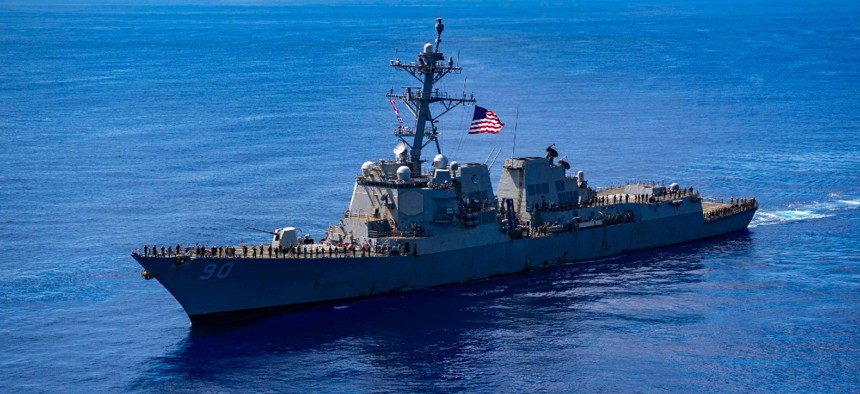Navy Eyes a Future Where IT Services Are Common—and Not Duplicated

Sailors aboard Arleigh Burke-class guided-missile destroyer USS Chafee man the rails in preparation for a passing honors ceremony with Japan Maritime Self-Defense Force Murasame-class destroyer JS Ikazuchi and Kongo-class guided-missile destroyer JS Chokai Sept. 19. Haydn N. Smith/Navy
Officials will first focus on core IT capabilities and expand as use cases demand.
The Navy is set to completely reshape how it develops and deploys information technology services and aims to embrace a new style that will enable digital tools to be swiftly adopted and shared across its entire organization and all of its subcomponents.
In a memorandum released last week, the branch’s Chief Information Officer Aaron Weis and Acting Assistant Secretary of Research, Development, and Acquisition Frederick Stefany articulated broad plans to begin a strategic shift toward an enterprise IT services approach.
“This transition is fundamental to reducing waste and duplication; increasing data availability; maintaining pace with modern industry practices; accelerating productivity; and, reducing cyber risk,” they wrote.
Conflicts are moving from the physical world more into cyberspace, and the U.S. military is trying to adapt. Navy officials, including Weis, have been candid about the need to “dramatically” modernize their infrastructure. Last year, the branch released its Information Superiority Vision—an IT revamp plan that deemed its current “antiquated systems” inadequate for the modern mission. This newly released memo builds on that vision. It also comes as the Defense Department pursues its multibillion-dollar Joint All-Domain Command and Control, or JADC2, initiative to enable a synergistic network of technology capabilities tapped across all branches and domains.
Via the memo, Weis and Stefany noted that enterprise IT services “consist of a technology solution paired with appropriate use case(s), enabling their reuse whenever those use cases are encountered”—and that they must be lean, responsive to feedback and enabling in that “teams do not need to be coerced into adoption.” Where it makes sense technically and financially, such assets will need to extend to the tactical edge to boost interoperability and data sharing.
“The intent of enterprise IT services is to operate across more than one network, security domain, system, or organizational unit,” Weis and Stefany wrote.
Initial use cases they’ll pursue in this endeavor could be associated with Identity, Credential, and Access Management; Model Based System Engineering capabilities; cloud platform services; or data analytics services, according to the document. Insiders will first prioritize “core IT services,” like those, but intend to expand their scope based on operational demands.
Within 60 days of the memo’s release, the Navy’s chief technology officer is directed to form and lead a forum “to define policy, roles, and processes required for identification and adoption of enterprise IT services.” After it’s established, the group will draft, review and seek approval on “foundational policies and procedures for enterprise IT services.” The forum’s anticipated outputs include identifying a standard IT service management reference model that covers cybersecurity assessment and authorization, an IT-aligned taxonomy for products, suggestions for areas to focus on in the near-term, roles and responsibilities associated with such services and more.



